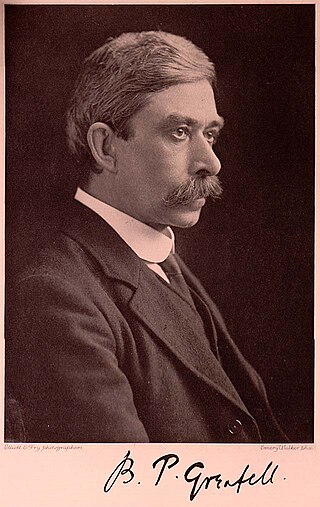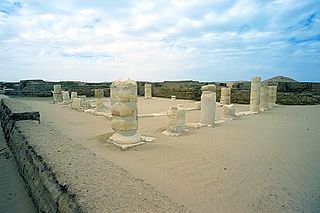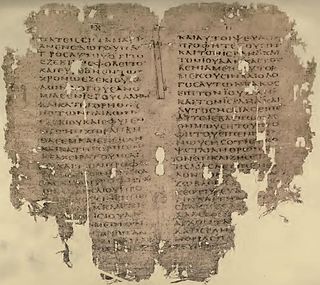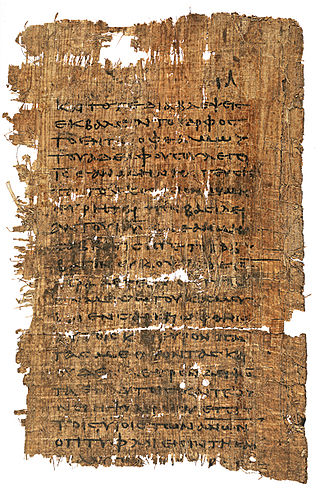
Papyrus is a material similar to thick paper that was used in ancient times as a writing surface. It was made from the pith of the papyrus plant, Cyperus papyrus, a wetland sedge. Papyrus can also refer to a document written on sheets of such material, joined side by side and rolled up into a scroll, an early form of a book.

The Elephantine Papyri and Ostraca consist of thousands of documents from the Egyptian border fortresses of Elephantine and Aswan, which yielded hundreds of papyri and ostraca in hieratic and demotic Egyptian, Aramaic, Koine Greek, Latin and Coptic, spanning a period of 100 years in the 5th to 4th centuries BCE. The documents include letters and legal contracts from family and other archives, and are thus an invaluable source of knowledge for scholars of varied disciplines such as epistolography, law, society, religion, language and onomastics. The Elephantine documents include letters and legal contracts from family and other archives: divorce documents, the manumission of slaves, and other business. The dry soil of Upper Egypt preserved the documents.

Papyrology is the study of manuscripts of ancient literature, correspondence, legal archives, etc., preserved on portable media from antiquity, the most common form of which is papyrus, the principal writing material in the ancient civilizations of Egypt, Greece, and Rome. Papyrology includes both the translation and interpretation of ancient documents in a variety of languages as well as the care and conservation of rare papyrus originals.

Oxyrhynchus, also known by its modern name Al-Bahnasa, is a city in Middle Egypt located about 160 km south-southwest of Cairo in Minya Governorate. It is also an important archaeological site. Since the late 19th century, the area around Oxyrhynchus has been excavated almost continually, yielding an enormous collection of papyrus texts dating from the Ptolemaic Kingdom and Roman Egypt. They also include a few vellum manuscripts, and more recent Arabic manuscripts on paper

William Amhurst Tyssen-Amherst, 1st Baron Amherst of Hackney, was a British Conservative Member of Parliament and collector of books and works of art.

Bernard Pyne GrenfellFBA was an English scientist and egyptologist.

Tebtunis was a city and later town in Lower Egypt. The settlement was founded in approximately 1800 BCE by the Twelfth Dynasty king Amenemhat III. It was located in what is now the village of Tell Umm el-Baragat in the Faiyum Governorate. In Tebtunis there were many Greek and Roman buildings. It was a rich town and was a very important regional center during the Ptolemaic period.

Arthur Surridge Hunt, FBA was an English papyrologist.

The Oxyrhynchus Papyri are a group of manuscripts discovered during the late nineteenth and early twentieth centuries by papyrologists Bernard Pyne Grenfell and Arthur Surridge Hunt at an ancient rubbish dump near Oxyrhynchus in Egypt.

Uncial 076, α1008 (Soden), is a Greek uncial manuscript of the New Testament, dated palaeographically to the 5th or 6th-century. Formerly it was labeled by יa.

The Rylands Papyri are a collection of thousands of papyrus fragments and documents from North Africa and Greece housed at the John Rylands University Library, Manchester, UK. The collection includes the Rylands Library Papyrus P52, also known as the "St John's fragment", a fragment from a papyrus codex, generally accepted as the earliest extant record of a Canonical gospel.

Papyrus Oxyrhynchus 1 is a papyrus fragment of the logia of Jesus written in Greek. It was among the first of the Oxyrhynchus Papyri discovered by Grenfell and Hunt. It was discovered on the second day of excavation, 12 January 1897, in the garbage mounds in the Egyptian town of Oxyrhynchus. The fragment is dated to the early half of the 3rd century. Grenfell and Hunt originally dated the fragment between 150 and 300, but "probably not written much later than the year 200." It was later discovered to be the oldest manuscript of the Gospel of Thomas.
Papyrus Oxyrhynchus 654 is a papyrus fragment of the logia of Jesus written in Greek. It is one of the Oxyrhynchus Papyri discovered by Grenfell and Hunt between 1897 and 1904 in the Egyptian town of Oxyrhynchus. The fragment is dated to the middle or late of the 3rd century. It is one of only three Greek manuscripts of the Gospel of Thomas.

Papyrus Oxyrhynchus 655 is a papyrus fragment of the logia of Jesus written in Greek. It is one of the Oxyrhynchus Papyri discovered by Grenfell and Hunt between 1897 and 1904 in the Egyptian town of Oxyrhynchus. The fragment is dated to the early 3rd century. It is one of only three Greek manuscripts of the Gospel of Thomas.

Papyrus Amherst 3a is a fragment of a letter from Rome of an unknown author, written in Greek. The manuscript was written on papyrus in the form of a scroll. It is dated to the third century. It was discovered by Grenfell and Hunt. It is one from the earliest Christian documents. A certain Maximus the pope is mentioned in this document.
Papyrus Oxyrhynchus 581 is a papyrus fragment written in Ancient Greek, apparently recording the sale of a slave girl. Dating from 29 August 99 AD, P. Oxy. 581 was discovered, alongside hundreds of other papyri, by Bernard Pyne Grenfell and Arthur Surridge Hunt while excavating an ancient landfill at Oxyrhynchus in modern Egypt. The document's contents were published by the Egypt Exploration Fund in 1898, which also secured its donation to University College, Dundee, later the University of Dundee, in 1903 – where it still resides. Measuring 6.3 x 14.7 cm and consisting of 17 lines of text, the artifact represents the conclusion of a longer record, although the beginning of the papyrus was lost before it was found. P. Oxy. 581 has received a modest amount of scholarly attention, most recently and completely in a 2009 translation by classicist Amin Benaissa of Lady Margaret Hall, Oxford.
The Philinna Papyrus is part of a collection of ancient Greek spells written in hexameter verse. Three spells are partially preserved on the papyrus. One is a cure for headache, one probably for a skin condition, and the purpose of the third spell is uncertain. Two fragments of the papyrus survive, in the collections of the Morgan Library & Museum, New York, and the Berlin State Museums.
Phernouphis was a town of Ancient Egypt, in the Mendesian nome. It was capital of the eponymous Phernouphite toparchy. It was located at the site of Barnufa, which was a hod or irrigation basin located 3.5 km (2.2 mi) southwest of Dekernes, within the territory of Tanah, but the site has since been covered up by modern construction.

Papyrus Amherst 63 is an ancient Egyptian papyrus from the third century BC containing Aramaic texts written in demotic script. The 35 texts date to the eighth and seventh centuries BC.
Astarte and the Insatiable Sea or pAmherst IX is an Egyptian hieratic retelling of an imported Canaanite story about the Ugaritic goddess Astarte and here rivaling Yam.















